Brewer’s yeast engineered to produce potential cancer drug
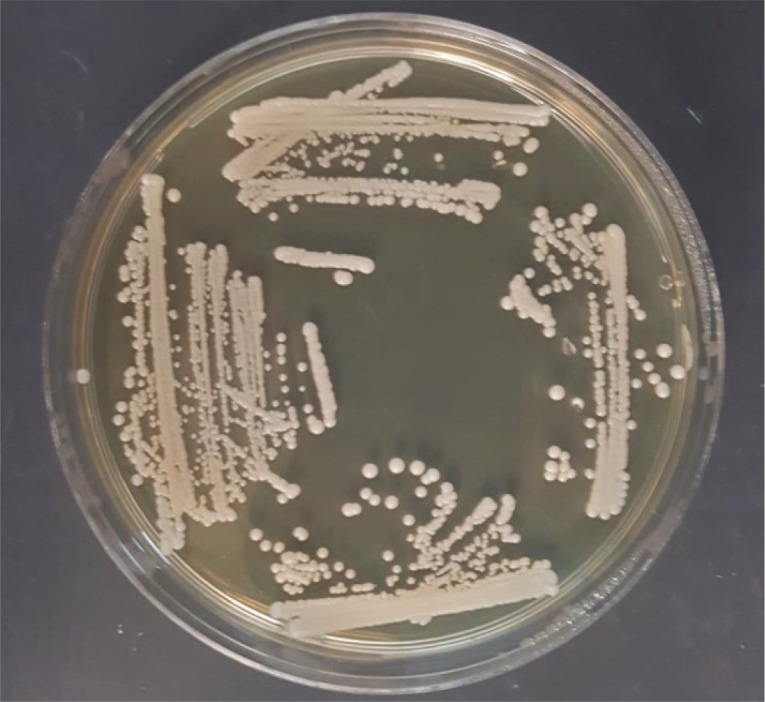
Brewer’s yeast.
Noscapine, a widely used nonnarcotic cough suppressant, can act as a potential cancer drug with purportedly fewer side effects than conventional chemotherapy when administered in high doses. The drug is extracted from opium poppy straws, but poppy farming is time-consuming, prone to environmental vagaries, and can introduce narcotic alkaloids into pharmaceutical supply chains. More importantly, noscapine cannot be easily chemically synthesized at commercial scales for medical testing and use. Building on previous work that uncovered a 10-gene cluster underlying noscapine synthesis in opium poppies, Yanran Li et al. (pp. E3922–E3931) assembled a complete biosynthetic pathway composed of 31 bacterial, yeast, plant, and mammalian enzymes, including technically daunting membrane-bound enzymes, into a single strain of brewer’s yeast (Saccharomyces cerevisiae). The engineered yeast strain produced 120–230 ng/L noscapine. By optimizing enzyme activity and expression levels, regenerating cofactors to improve enzyme efficiency, and altering fermentation conditions and the composition of the growth medium, the authors boosted production by a factor of 18,000, resulting in 2.2 mg/L noscapine. Though commercial manufacture requires a further 100-fold to 1,000-fold increase in noscapine titers, the findings demonstrate the feasibility of using yeast for the large-scale conversion of simple carbon and nitrogen sources into a medically important plant alkaloid, according to the authors. — P.N.
Near-infrared dyes for shortwave infrared fluorescence imaging
Fluorescence imaging using shortwave infrared (SWIR) wavelengths offers higher contrast, sensitivity, and penetration depth, compared with visible and near-infrared (NIR) fluorescence imaging. However, the lack of FDA-approved fluorophores has limited the utility of SWIR fluorescence imaging in clinical settings. Jessica Carr et al. (pp. 4465–4470) demonstrate that commercially available NIR dyes—such as the FDA-approved dye indocyanine green (ICG)—are suitable for in vivo SWIR fluorescence imaging. The authors found that although these dyes have a peak emission in the NIR spectral region, they outperformed commercially available SWIR fluorophores. The authors report that ICG can be used for real-time SWIR fluorescence imaging with increased contrast, including noninvasive imaging of the brain vasculature, small intestine, and lymphatic system in mice, compared with NIR imaging. Further, the authors suggest that new SWIR fluorophores should be benchmarked against ICG SWIR emission in blood. The authors conjugated IRDye 800CW, an NIR dye currently in multiple clinical trials, to the tumor-targeting antibody trastuzumab and showed that the dye could be used for noninvasive SWIR imaging of tumors. According to the authors, SWIR imaging with ICG could be developed for human clinical applications, and commercially available NIR dyes could be used to perform high-contrast SWIR imaging by switching NIR cameras to SWIR cameras. — S.R.
Tradeoffs between inflammation and growth
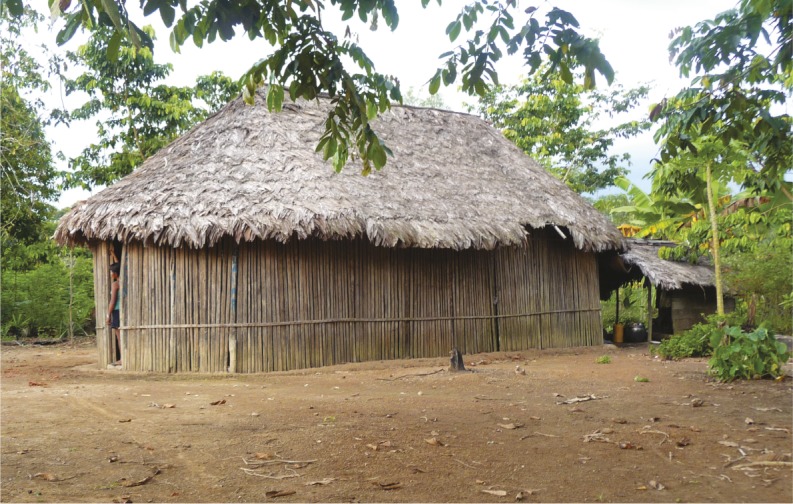
Traditional Shuar home.
Humans allocate energy expenditures in the form of calories to various metabolic tasks at different times, with tradeoffs occurring as some tasks, such as immune function, receive increased energy and other tasks, such as growth, receive decreased energy. Samuel Urlacher et al. (pp. E3914–E3921) measured growth, subcutaneous body fat, and immune biomarkers in 261 children, ages 4–11, who are members of the Amazonian Shuar indigenous group. The study participants are forager-horticulturalists who consume a diet with low nutrient density and experience high rates of parasitic and infectious disease. The authors found that children expressing mild acute inflammation displayed a 49% reduction in concurrent growth. Various immune biomarkers reflecting different branches of immune function were associated with impacts on growth that lasted from 1 week to more than 1 year. The children with the highest body fat, however, exhibited no reduction in growth during periods of inflammation, suggesting that adipose tissue served to meet the energy shortfalls associated with immune function. According to the authors, the tradeoff between growth and immune function suggests that immune energetics likely shape patterns of human life history and may have contributed to the development of an extended childhood in human evolution. — P.G.
One-step, low-cost synthesis of black phosphorus
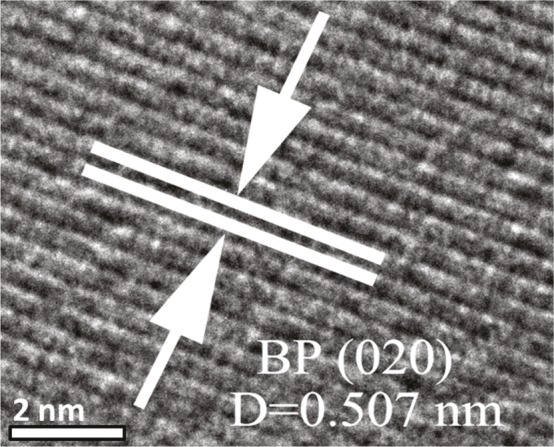
High-resolution transmission electron micrograph of a BP flake, showing the lattice and the interlayer spacing of 0.507 nm.
Similar to graphene, black phosphorus (BP) is a 2D material with potentially wide applications. Currently, BP nanosheets are produced by exfoliation from a bulk material, a process that is impractical for scaled-up production. Further, BP nanosheets degrade rapidly. Bin Tian et al. (pp. 4345–4350) developed a method for BP chemical synthesis using white phosphorus and ethylenediamine, which are common laboratory reagents, at temperatures between 60 and 140 °C. The method produced gram-scale few-layer quantities of BP. Partial oxidation of the material during synthesis was found to enhance the material’s stability, as the material exhibited little degradation over 4 months. The thickness of the layers produced was dependent on temperature, and the process produced the highest yield at 140 °C with overall costs less than $1 per gram, compared to around $500 per gram for bulk BP samples. To demonstrate the properties of the synthetic BP, the authors compared the material’s performance as a water-splitting catalyst against C3N4, a catalyst currently in use. The hydrogen evolution rate was 24 times higher for BP than for C3N4, and using platinum as a cocatalyst with BP increased hydrogen evolution rate an additional 30-fold. According to the authors, the BP production process yields stable, low-cost material that can serve as a metal-free catalyst for artificial photosynthesis. — P.G.
Macrophages prevent cancer-fighting T cells from reaching tumors
The goal of cancer immunotherapy is to activate an efficient immune response against tumors, but this strategy currently does not work in most patients. Various barriers prevent T cells from reaching tumors, resulting in resistance to immunotherapy. Elisa Peranzoni et al. (pp. E4041–E4050) provide evidence in mice and humans that immune cells called macrophages play a key role in resistance by sequestering T cells outside tumors. Analysis of fresh tumor slices from patients with lung cancer revealed that macrophages form long-lasting, relatively static interactions with T cells in the microenvironment surrounding tumor cells. In two mouse models of breast cancer, treatment with a macrophage-depleting, clinically tested drug called pexidartinib led to greater T cell motility and a strong increase in the percentage of T cells at tumor sites, compared with no treatment. The authors next treated the mice with pexidartinib in combination with an anti–PD-1 antibody, a clinically approved class of immunotherapy drug that allows T cells to kill cancer cells effectively. Combination therapy further increased the proportion of T cells in stable contact with tumor cells and resulted in smaller tumors, compared with either treatment alone. According to the authors, the results suggest that depleting macrophages boosts the ability of T cells to infiltrate tumors, potentially overcoming a major resistance mechanism to cancer immunotherapy. — J.W.
How musks activate odorant receptors
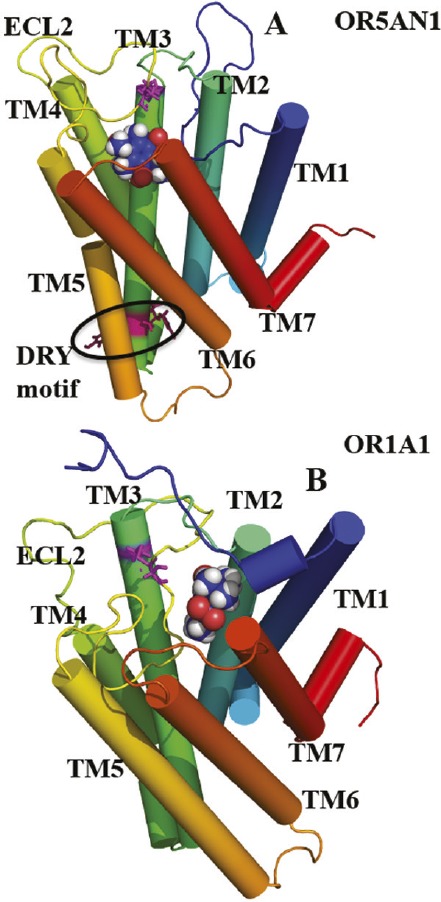
OR5AN1 and OR1A1 models. TM: transmembrane α-helix. ECL: extracellular loop.
Musks are aromatic substances that are widely used in perfumery and traditional Chinese medicine. However, how musks exert their powerful olfactory effects has remained unclear, partly due to the lack of structural models of odorant receptors. Lucky Ahmed et al. (pp. E3950–E3958) combined computational and experimental approaches to examine the activation of the recently identified human musk receptors, OR5AN1 and OR1A1. The authors used molecular simulations to develop structural models of OR5AN1 and OR1A1. The structural models predicted binding sites for different types of musks and identified receptor amino acid residues that mediate odorant binding. To validate the models, the authors measured receptor responses upon odorant binding and conducted site-directed mutagenesis experiments, which involved changing the DNA sequence encoding key amino acid residues and examining the effects on receptor activation profiles. The authors report that OR5AN1 responds to both macrocyclic musks and nitromusks, whereas OR1A1 responds prominently only to nitromusks. Moreover, the stable binding of OR5AN1 to odorants depends on the amino acid residues Tyr260, Phe105, Phe194, and Phe207. By contrast, OR1A1 stabilization of nitromusks relies on Tyr258, Tyr251, and Phe206. According to the authors, insights into musk odorant–receptor interactions might enable the study of the pharmacological effects of musks. — J.W.
Genetic diversity and continuity in Patagonia
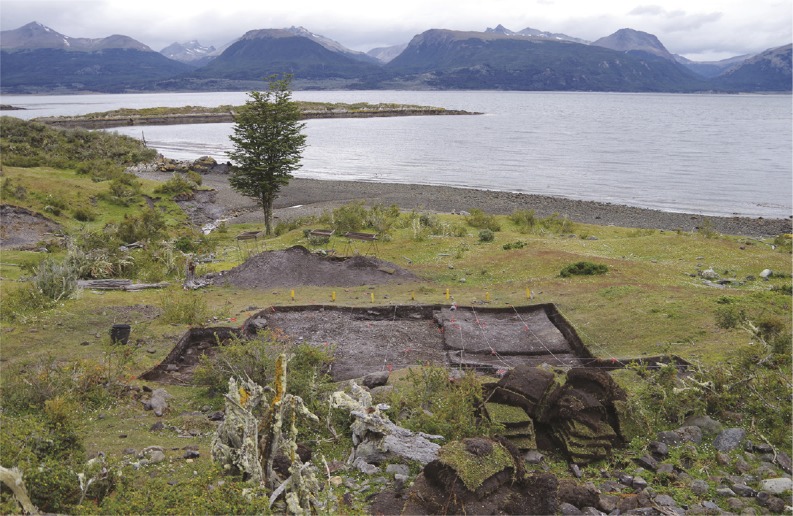
Shell midden on Navarino Island overlooking the Beagle Channel. Image courtesy of Ismael Martínez Rivera (Instituto de la Patagonia, Punta Arenas, Chile).
Previous genomic studies in the Americas have focused on the timing of early migration throughout the continent and the split of major subcontinental lineages. Such studies, however, have not addressed regional genetic diversity among Patagonian ethnic groups. Constanza de la Fuente et al. (pp. E4006–E4012) sequenced genomic data from four ancient individuals and 61 modern individuals in south–central Chile and Patagonia. Among the groups analyzed were late maritime groups from western and southern Patagonian archipelagoes, previously published ancient genomes from historical maritime Kawéskar and Yámana groups, and the terrestrial Selk’nam group from Tierra del Fuego. The authors found that despite the challenges to genetic continuity that came with European colonization, modern Kawéskar and Yámana retain a high genetic affinity with ancient individuals, suggesting high genetic continuity over the past 1,000 years. The authors also found that maritime individuals were genetically equidistant from the ancient Selk’nam individual, suggesting that the maritime groups split from the terrestrial group at around the same time, possibly around the time Tierra del Fuego became isolated from the mainland by the Magellan Strait. According to the authors, the results enhance the representation of Native American groups among genetic databases and offer insight into the origins and development of maritime cultures in Patagonia. — P.G.


